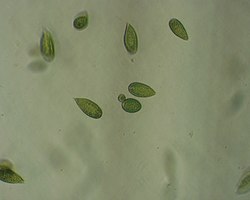Characteristics
All raphidophytes are unicellular, with large cells (50 to 100 μm), but no cell walls. Raphidophytes possess a pair of flagella, organised such that both originate from the same invagination (or gullet). One flagellum points forwards, and is covered in hair-like mastigonemes, while the other points backwards across the cell surface, lying within a ventral groove. Raphidophytes contain numerous ellipsoid chloroplasts, which contain chlorophylls a, c1 and c2. They also make use of accessory pigments including β-carotene and diadinoxanthin. Unlike other heterokontophytes, raphidophytes do not possess the photoreceptive organelle (or eyespot) typical of this group.
In terms of ecology, raphidophytes occur as photosynthetic autotrophs across a range of aquatic systems. Freshwater species are more common in acidic waters, such as pools in bogs. Marine species often produce large blooms in summer, particularly in coastal waters. Off the Japanese coast, the resulting red tides often cause disruption to fish farms, although raphidophytes are not usually responsible for toxic blooms.
Classification
The position of this group varied in former classifications. Some protozoologists treated chloromonads as an order within the phytoflagellates. [4] Some phycologists classified them with the Xanthophyceae and the Eustigmatophyceae in the division Xanthophyta. [8] Others considered them as related to the Chrysophyceae, Dinophyceae, or Cryptophyceae. [9] Cavalier-Smith proposed them as a subclass of algae within the class Raphidomonadea, which also included the heliozoan group Actinophryida and the enigmatic flagellate Commation . [10] [2]
Currently, raphidophytes consist of the class Raphidophyceae, [7] which contains only one order Chattonellales composed of four families. [3]
Several genera have been proposed as raphidophytes but their position remains uncertain. The genus Oltmannsia Schiller 1925 was tentatively placed in the order Chattonellales by Jahn Throndsen in 1993, [12] : 30 [13] : 511 but it is not included in later studies. Similarly, the genus Swirenkoiamonas Skvortzov 1968 was described as a member of the Chloromonadales, [14] was later regarded as a euglenid in 1991, [15] : 428 and is not mentioned by subsequent studies. [7] The genus Olisthodiscus was originally proposed as a raphidophyte, [12] : 30 but it currently composes a separate class, Olisthodiscophyceae. [16]
This page is based on this
Wikipedia article Text is available under the
CC BY-SA 4.0 license; additional terms may apply.
Images, videos and audio are available under their respective licenses.
